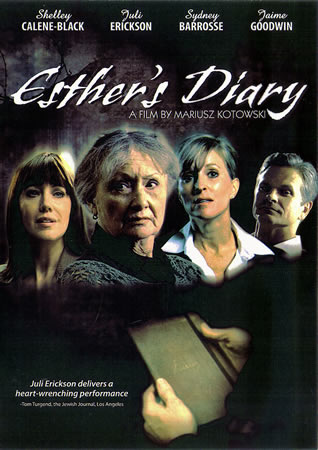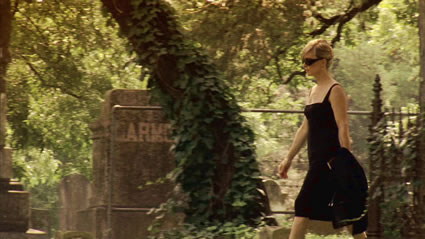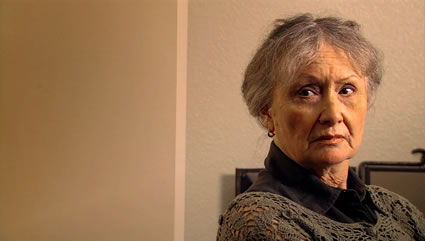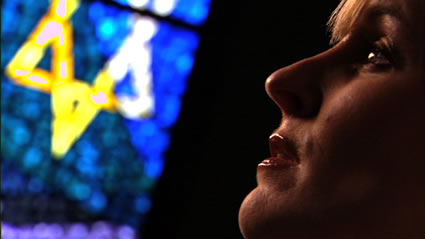|
The |
||||||||||||||||||||
| Home |
|
|||||||||||||||||||
 |
Esther's Diary A
film by Mariusz Kotowski
(director of Featuring Juli Erickson (Apollonia), Shelley Calene-Black (Maria), Sydney Barrosse (Sarah), Jamie Goodwin (Jeff), Wilbur Penn (Clayton) Screenplay
by Allan Knee, from a story by Mariusz Kotowski Executive Producer: Heidi Hutter / Bright Shining City Productions Running time:
74:25 |
A review by David Gasten
The Holocaust Movie is now officially a genre movie, with over 400 titles and counting. Both the years 2008 and 2009 saw an onslaught of big-budget Hollywood Holocaust Movies timed to play theaters at the end of the year in hopes of winning an Oscar because of the Pavlovian sympathy that the subject seems to elicit.
However, movie-watching audiences
seem to come to point where they feel the subject of the Holocaust is being exploited a means to an end, rather
than as an honest way to tap into the stories that Holocaust survivors and their descendants have to tell.
Maybe the most influential and quoted current opinion piece on this
subject is by Jewish author Stewart Klawans, which is appropriately
entitled “Saying
‘Never Again’ To Holocaust
Movies.”
Holocaust Movie survivors
have endured silly, clichéd stories about happy concentration campers and
wannabe Hitler assassins, and soft-core porn-riddled stories that are tied
into the Holocaust for Oscar appeal, when they were hoping to see a Holocaust
movie that was genuine and actually tapped into the stories of the period.
And now, the movie that they really wanted to
see is finally here: Esther’s Diary, the
Holocaust Movie To End All Holocaust Movies.
What Makes Esther’s Diary Seem So
Genuine?
|
In this behind-the-scenes short subject, director Mariusz Kotowski discusses the stories that his Polish Catholic grandparents told him which inspired the story of Esther's Diary. The uncommonly genuine vibe of this Holocaust movie comes across in the interviews with the cast members as well as the interview footage with director Kotowski. |
Esther’s Diary manages to feel genuine and real instead of exploitive and fake because the stories that it tells are actually a composite of the many stories that director Mariusz Kotowski heard from his Polish Catholic grandparents. Kotowski’s grandparents were involved in hiding Jews from their German oppressors during World War II; they still live in Poland and are currently in their nineties. Polish Catholics and Polish Jews lived together peaceably for 500 years, so when the Nazis began seeking out Jews in Poland to haul away to concentration camps, their Polish Catholic neighbors worked to protect them, hiding them in cellars and procuring food for them. One of these “cellar stories” became an important device that Esther's Diary's plot is based upon.
Atop this, Mark Chait,
a Jewish man from Australia whose mother was a Holocaust survivor, scored
the movie. These
first-generation connections with the Holocaust give the movie an urgency
and realism that Oscar-baiting Holocaust movies with ten times the budget
could not hold a candle to.
A Fifty-Year follow-up to Night And Fog
Esther’s Diary
works as a 50-year follow-up to the classic short subject Night and
Fog (Nuit et Broulliard, 1955). The 30-minute French
documentary was filmed a little over a decade after the story of the
Holocaust was uncovered and leaked to the world, and juxtaposes color
footage of the overgrown ruins of the German concentration camps with
disturbing imagery of the sadistic structures, skeleton-like bodies, and
rotting corpses inside the camps.
|
A thirty-two second clip of the infamous Night and Fog (1955), featuring some of its less disturbing imagery. This clip features an example of how color footage was contrasted with black and and white footage, a pattern which Esther's Diary follows in. |
The old adage says “Time heals all wounds”, and Night and Fog and Esther’s Diary sample two places and time periods, together showing both the nature of the wound and how it has healed over the years. Like Night and Fog, Esther’s Diary juxtaposes black and white footage with color footage to differentiate the two different periods.
At five different points
in Esther’s Diary, the movie dissolves into a narrative about the
camps as seen though the eyes of Esther Horn, the title character.
Three of these narratives are accompanied by holocaust footage
procured from the Auschwitz State Museum in Germany, some of which comes
from the exact same source material as the footage in Night and Fog.
Although only 2 ½ minutes of Holocaust footage is in Esther’s Diary,
it is moving enough that it seems like there is about three times as much
as there is.
Esther’s Diary Plot
Outline
 |
|
One of a number of walking scenes, which feature two women, and are interwoven to show that the two ladies are slowly gravitating toward finding each other. |
The beginning of Esther’s
Diary cuts between two women who are walking and walking, as if
unknowingly trying to find each other.
Black and white footage of a little girl wandering through a forest
confirms this. We learn that one woman, Maria Patterson, is a teacher by day
and a radio show host by night, and is happily married (so she thinks) to
a touring orchestra musician named Jeff.
The other is a successful architect named Sarah Blumenfeld.
Sara’s mother, Esther Horn-Blumenfeld, died just two weeks prior,
and willed her a memoir of her past experiences as a child in a German
concentration camp.
Sarah and Maria start
working their way into each other’s lives via an old woman in a rest
home named Apollonia Kowalski. As
the story unfolds, we learn that Apollonia is Maria’s mother and was
Esther’s (Sarah’s mother’s) best friend.
Both Sarah and Maria had cold, distant relationships with their
mothers, which largely stemmed from the trauma the Holocaust brought into
the two older women’s lives. Sarah meets Apollonia in person, and accidentally stumbles
upon Apollonia’s greatest regret: an incident where she accidentally
leaked the information about Esther and her family’s whereabouts to the
Germans, which led to the family being led away to the camp.
The resurfacing of this incident arrives just in time to allow
Maria and Apollonia to open up to each other and the two daughters to find
each other and come together, just as tragedy strikes Maria twice in a row
and alters her life forever.
Realistic, Loveable
Characters
|
The cast of Esther's Diary talk in depth about the characters in the movie. Interviewees include Juli Erickson (Apollonia, the Pola Negri-based character), Sydney Barrossee (Sarah), Wilbur Penn (Clayton, pictured above), and Dell Aldrich (the narrative voice of Esther). |
Director Kotowski and
scriptwriter Allan Knee spent a lot of time developing realistic,
loveable on-screen characters for Esther’s Diary in a day and age
when many movie characters are as shallow, thin, and detached from real
life as the industry people who create them.
Maria is an everyday heroine with a combination of strengths and
vulnerabilities that causes you to fall in love with her.
Sarah Blumenfeld is a searching, unhappy professional like many
you’ve probably met in your life. Clayton, Maria’s co-worker, is a
wisecracking white-collar African-American with lovable black-culture
charm and humor. His
quick-witted bantering with Maria is an outer symptom of a soft spot he
has in his heart for her—the same soft spot Maria claims in the
viewer’s heart over the course of the movie.
Even Jeff, Maria’s
estranged husband, does not fall into the cowardly, John Ritter cliché
that many male characters fall into in today’s movies.
You can absolutely see why both Maria and Jeff's younger mistress
are so in love with him, and why Maria is so trusting of him. He is strong
and “man-of-his-word” masculine to the point that it seems out of
character for him to jilt Maria for some girl in the orchestra.
The Pola Negri Character
 |
|
The character Apollonia Kowalski, played by Juli Erickson, is heavy inspired by Pola Negri. |
By far the most important
character in the movie is Apollonia Kowalski, the Polish woman in
the nursing home whose Holocaust secret gets sprung about halfway
into the movie. We are aware
of her as a ghost-like off-screen figure until she makes a dramatic
entrance 20 minutes into the movie. The
Apollonia character is important to Pola Negri fans because she is a
character in a modern-day movie that directly and heavily inspired by Pola
Negri.
One of Kotowski’s notable previous films was the 2006 Life is a Dream in Cinema documentary about Pola Negri. Kotowski purposely created in Apollonia a character that he felt Pola would enjoy playing as an old woman, and endowed the character with many of Pola’s real-life attributes. He chose an actress, Juli Erickson, that physically looks like Pola in many ways. And most noticeably, he named the character Apollonia, which the name “Pola” is a contraction of, and draws attention to the name throughout the movie. I don’t think there is another contemporary movie character that is this inspired by Pola, so this in and of itself makes the movie of interest to Pola Negri fans.
Landing People Together
Early in the movie, the
character Sarah Blumenfeld walks past a service mark on the wall at her
architectural firm that reads: “Landing. People. Together.”
Bringing people together was director Kotowski’s passion and
focus throughout this movie. Again, this goes back to his Polish roots,
when his Polish Catholic grandparents hid their Jewish neighbors from the
Nazi authorities.
 |
|
Sarah praying in her synagogue. In the film, Sarah is Jewish and Maria is a Roman Catholic. |
In the movie, Maria is a
Catholic and Sarah is a Jew, and both of them are seen in their respective
church and synagogue performing religious rites and finding solace in
those rites. And yet, when they come together as friends, their religious
differences doesn’t seem to bother them at all, just as was the case
with their parents. Their
search for love and quest to find meaning in life, conditions that we all
share, is what brings them together, as does their shared Polish heritage.
Being a bicultural Polish-American, director Kotowski also worked to bring the Polish and American cultures together via the reconciliation between Maria and Apollonia. Maria is fully American and feels no ties to Poland whatsoever, whereas Apollonia is strongly Polish in every way. Part of the reconciliation comes when Apollonia asks Maria to take her to Poland with her, and Maria agrees to do so. Another part is when Apollonia opens her terrible secret up to Maria. There is a sense of universal humanity that comes out in this incident that reaches across time and between countries, and brings the two together where there was fighting and bickering before.
Attention to Detail in the Cinematography
Watching this movie, one
can’t help but think, “The filmmakers have literally thought of
everything!” Not only is there an incredible amount of detail in the story
and the characters, but the photography also has a depth and attention to
detail that keeps the movie consistently absorbing.
Director Kotowski’s
love for old movies and his European background inform his directorial
style, and give his work a depth that many other filmmakers lack. Kotowski
and his cameramen experiment with many cinematic looks and styles, but
bring everything together in a way that is cohesive and underscores the
narrative. The visuals bring
even more interest and substance to the story without getting in the way
and turning the movie into a pretentious art film.
 |
|
One of the many beautifully-photographed scenes in Esther's Diary, this one being where Maria's cheating husband Jeff is waiting for his mistress at a nightclub. Jeff's character (played by Jamie Goodwin) is atypically gentlemanly to the point that his infidelity seems out of character for him. |
Kotowski opens the film
with clever CGI opening credits that dissolve from Stars of David and
crosses overlaid on ghostly stills of the concentration camps.
He then inserts documentary-like panning shots of a graveyard,
before focusing on a headstone that looks like it came from a
black-and-white 1940's movie. The
nightclub scene where we learn that Maria’s husband Jeff is cheating on
her features hard lighting and a red velvet curtain background, which we
associate with modern recreations of the class of the mid-1900’s.
The dialogue scenes between Maria and Apollonia have a slightly
grainy analog look with a yellowish tint that we associate with late
1980’s dramas. And the
lively banter between Clayton and Maria in the office setting features
equally lively color oversaturation.
And yet all of this variety seems natural and does not get in the
way of the film itself.
Coming to DVD in September
Esther’s Diary
is currently making the rounds in the festival circuit, but will be
available on home video in September 2010.
Watch this space for ordering details.
In the meantime, visit the movie’s official website at www.esthersdiarymovie.com
and watch the behind the scenes clips on YouTube for a preview.
I would recommend watching Esther’s Diary back to back with Night and Fog since the two films complement each other both in cinematographic style and as a quasi-historical narrative. It will make for a powerful evening of movie watching, and will allow you to look back on the period, hear some of the stories, and walk away with perspective on the Holocaust, instead of feeling exploited and pandered to so that somebody could get their Oscar.
|
The cast of Esther's Diary talks about working with director Mariusz Kotowski, and both the cast and director offer parting thoughts about the affect of the Holocaust on later generations. Esther's Diary will be available on DVD in September 2010. |
(back to Articles and Movie Reviews)
Pola
Documentary:
Life is a Dream in Cinema
Now on
DVD!
